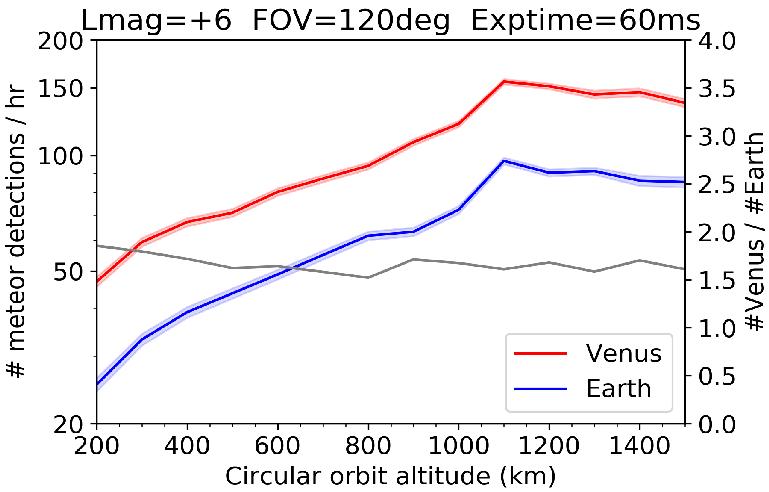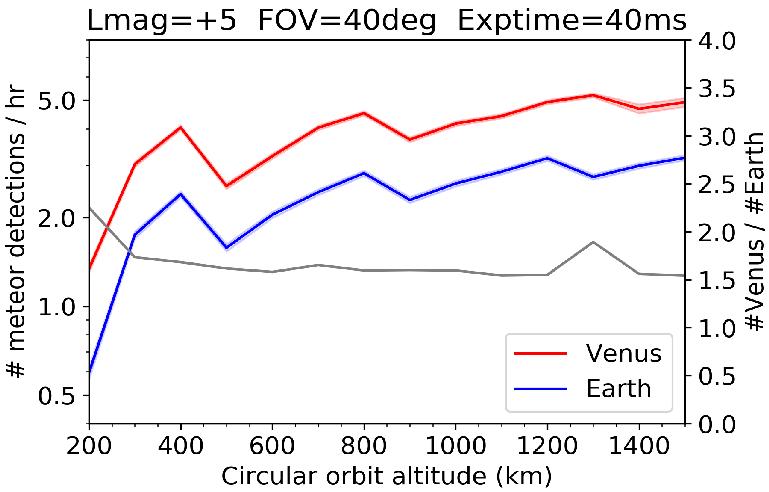EPSC Abstracts
Vol. 17, EPSC2024-204, 2024, updated on 03 Jul 2024
https://doi.org/10.5194/epsc2024-204
Europlanet Science Congress 2024
© Author(s) 2024. This work is distributed under the Creative Commons Attribution 4.0 License.
Characterising the meteoroid environment at 0.7 au from the sun with a Venus-orbiting meteor camera: a feasibility study
- 1Armagh Observatory and Planetarium, Armagh, United Kingdom of Great Britain – Northern Ireland (apostolos.christou@armagh.ac.uk)
- 2Faculty of Science, Gustav Hallstromin katu 2, FI-00014 University of Helsinki, Finland
- 3Swedish Institute of Space Physics (IRF), Kiruna, Sweden
- 4Institute of Physics and Technology, Ural Federal University, Mira str. 19, 620002 Ekaterinburg, Russia
While much is now known about the distribution of solar system dust down to nm-sized particles, the flux of mm-sized or larger grains is effectively unconstrained by direct observation outside of the Earth's immediate vicinity. Measuring the flux of those larger meteoroids requires using the surface area of an entire planet to record those particles as meteors burning up in the atmosphere. Cases in point are the SPOSH and EUSO/Mini-EUSO nadir-pointed optical-transient detector concepts [1,2] with the latter now successfully recording meteors from the International Space Station since 2019 [3,4]. The concept of an orbital meteor survey is particularly suited to the planet Venus, where the harsh surface environment and thick, opaque atmosphere preclude the use of ground-based assets for this purpose.
Figure 1: Magnitude-height profile for a 0.25g mass meteoroid ablating in the atmospheres of Venus and the Earth. The dashed lines indicate the heights of maximum light.
We have used physics-based modelling to assess the detectability of meteors in the upper atmosphere of Venus and to compare the efficiency of orbital meteor surveys at Venus vs the Earth [5]. Application of our ablation model to Venus confirms earlier findings [6] that Venus meteors would be brighter but shorter-lived than Earth meteors due to the different density scale heights (Fig 1). Meteors at Venus would typically appear at 85-125 km altitude, meaning an orbital survey would be unimpeded by the perennial cloud layers. Finally, we consider the performance of a hypothetical meteor detector on the future ESA EnVision mission similar to the Mini-EUSO instrument, finding that the intrinsically higher luminosity of meteors at Venus yields a detection rate 1.5x-2.5x the corresponding Earth rate (Fig 2). We further estimate that a Mini-EUSO-type instrument at Venus will yield 33-55 detections per hr of observing time, more than sufficient for a thorough characterisation of the >mm meteoroid population at 0.7 au from the Sun.


Figure 2: Hourly meteor detection rate at Earth and at Venus for cameras with similar characteristics to SPOSH (left) and to Mini-EUSO (right). The gray line represents the ratio of the number of meteors detected at the two planets.
References
[1] Abdellaoui, G., Abe, S., 358 co-authors, 2017. Meteor studies in the framework of the JEM-EUSO program. Planet. Space Sci. 143, 245–255. doi:10.1016/j.pss.2016.12.001. [2] Oberst, J., Flohrer, J., Elgner, S., Maue, T., Margonis, A., Schrödter, R., Tost, W., Buhl, M., Ehrich, J., Christou, A., Koschny, D., 2011. The Smart Panoramic Optical Sensor Head (SPOSH) - A camera for observations of transient luminous events on planetary night sides. Planet. Space Sci.
59, 1–9. doi:10.1016/j.pss.2010.09.016. [3] Bacholle, S., Barrillon, P., 59 co-authors, 2021. Mini-EUSO mission to study Earth UV emissions on board the ISS. Astrophys. J. Suppl. Ser. 253, 36. doi:10.3847/1538-4365/abd93d. [4] Coleman, A., Eser, J., 96 co-authors, 2023. Ultra high energy cosmic rays: The intersection of the cosmic and energy frontiers. Astroparticle Physics 147, 102794. doi:10.1016/j.astropartphys.2022.102794. [5] Christou, A.A., Gritsevich, M., 2024. Feasibility of meteor surveying from a Venus orbiter, Icarus, accepted for publication. doi: 10.1016/j.icarus.2024.116116. [6] McAuliffe, J.P., Christou, A.A., 2006. Modelling meteor ablation in the venusian atmosphere. Icarus 180, 1–22. doi:10.1016/j.icarus.2005.07.012.
How to cite: Christou, A. and Gritsevich, M.: Characterising the meteoroid environment at 0.7 au from the sun with a Venus-orbiting meteor camera: a feasibility study, Europlanet Science Congress 2024, Berlin, Germany, 8–13 Sep 2024, EPSC2024-204, https://doi.org/10.5194/epsc2024-204, 2024.